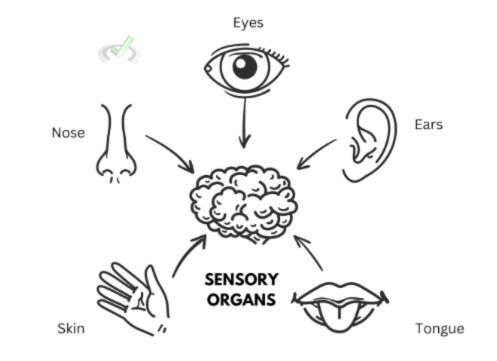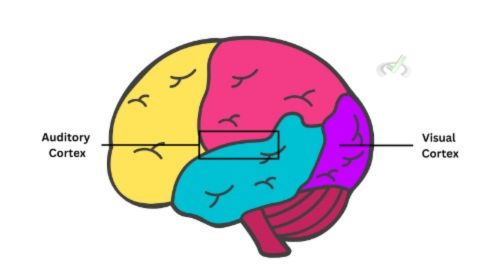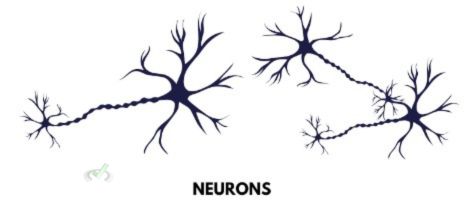Perception is how we understand and interpret the world around us. It involves all our senses, like seeing, hearing, touching, tasting, and smelling. This guide will explain the different processes in perception, the steps involved, and how these processes connect to other areas of psychology and neuroscience.
I. Understanding Perception: How We Make Sense of Sensory Information
Perception involves several steps that help us understand sensory input. Let's break down these steps:
A. Sensation: The Starting Point
Sensation is the first step in perception. It's when our sensory organs detect stimuli from the environment. Stimuli can be light, sound, smells, tastes, or touch. Our sensory organs then turn these stimuli into electrical signals that the brain can understand.
B. Attention: Focusing on Important Information
Attention is the process of focusing on specific stimuli while ignoring others. For example, in a noisy room, you can concentrate on a friend's voice and ignore background noise. This helps us focus on what matters most.
C. Organization: Grouping Sensory Inputs
Once we focus on specific stimuli, our brain organizes this information. It groups similar sensations to form a complete picture. For instance, we see a unified view, not just random objects, when looking at a scene.
This organization often follows rules known as Gestalt principles. These principles include similarity, where we group similar items, and proximity, where we group objects close to each other.
D. Interpretation: Making Sense of What We Perceive
Interpretation is when our brain gives meaning to the organized sensory information. This is how we understand what we see, hear, or feel. For example, when you hear a loud noise, you might understand it as thunder. Our brain uses past experiences and knowledge to help make these interpretations.
II. Key Components: Parts Involved in Perception
Different parts of our body and brain work together in the perception process.
A. Sensory Organs: The Detectors

Our sensory organs, such as the eyes, ears, nose, tongue, and skin, detect different types of stimuli. Each organ is specialized for a specific type of sensory input:
- Eyes detect light and color, helping us see.
- Ears detect sound waves, allowing us to hear.
- The nose detects smells, helping us identify scents.
- Tongue detects tastes, such as sweet, salty, bitter, and sour.
- Skin detects pressure, temperature, and pain, allowing us to feel different textures and sensations.
B. The Brain: The Processor
The brain processes the signals sent by the sensory organs. Different areas of the brain handle different types of sensory information. For example:
- The visual cortex processes visual information.
- The auditory cortex processes sounds.

C. Neural Pathways: The Messengers

Neural pathways are the routes that signal travel to reach the brain. These pathways consist of neurons, which are nerve cells that send information. Signals move along these pathways through synapses, where neurons communicate using chemicals called neurotransmitters. For example, the optic nerve carries visual signals from the eyes to the visual cortex.
III. Types of Perception: Breaking Down the Processes
There are different types of perception, each dealing with a specific kind of sensory input.
A. Visual Perception
Visual perception is how we understand what we see. It involves detecting light and color, recognizing shapes and patterns, and understanding depth and distance. Our brain uses bottom-up processing (analyzing basic elements) and top-down processing (using prior knowledge) to make sense of visual information.
B. Auditory Perception
Auditory perception is how we understand sounds. It includes detecting pitch, volume, and the direction of sounds. This type of perception helps us communicate with others, enjoy music, and be aware of our environment.
C. Tactile Perception
Tactile perception relates to our sense of touch. It involves detecting pressure, temperature, and pain. For example, we can distinguish between a soft pillow and a rough surface. This perception helps us perform tasks that require precise control, like typing or playing an instrument.
D. Olfactory and Gustatory Perception
Olfactory perception is our sense of smell, while gustatory perception is our sense of taste. These senses help us enjoy food and detect hazards like smoke or spoiled food. They also work together; for instance, our perception of flavor combines smell and taste.
IV. Issues in Perception: Understanding Perceptual Disorders
Perceptual disorders can affect how we interpret sensory information. These issues can come from problems in the sensory organs, neural pathways, or brain areas responsible for processing.
A. Visual Disorders
Visual disorders include conditions like color blindness, where a person can't distinguish certain colors, and amblyopia(lazy eye), where one eye does not develop proper vision. These issues can greatly affect daily activities like reading or driving.
B. Auditory Disorders
Auditory disorders, such as tinnitus (ringing in the ears) or hearing loss, affect the ability to hear sounds clearly. These conditions can result from damage to the ear, auditory pathways, or brain areas involved in hearing. For example, exposure to loud noises can damage the hair cells in the cochlea, leading to sensorineural hearing loss.
C. Sensory Processing Disorder
Sensory Processing Disorder (SPD) happens when the brain has trouble receiving and responding to sensory information. People with SPD may be overly sensitive to stimuli, like loud noises or bright lights, or under-sensitive, not noticing sensations that others do. This condition can affect daily life and is often seen in individuals with autism.
V. Bridge/Overlap
Perception connects to various areas in psychology and neuroscience, many of which are covered on the MCAT.
A. Cognitive Psychology and Perception
Cognitive psychology studies mental processes like perception, memory, and learning. Understanding perception helps explain how we process and store information. For example, visual and auditory cues are crucial in learning and memory recall.
B. Neuroplasticity and Perceptual Learning
Neuroplasticity is the brain's ability to change and adapt in response to experience. Perceptual learning involves improving our ability to perceive through practice. For instance, musicians develop a finer sense of pitch over time. This adaptability is also important in rehabilitation, where people can relearn skills after injury.
C. The Impact of Culture on Perception
Culture influences how we perceive the world. For example, cultural background can affect how we interpret facial expressions or gestures. Cross-cultural psychology studies these differences, helping us understand diverse perspectives and improve communication in a globalized world.
D. Integration and Cross-Modal Perception
Integration and cross-modal perception involve how our senses work together. For instance, when watching a movie, our visual and auditory systems work together to provide a complete experience. This integration is crucial in activities like reading lips or coordinating hand-eye movements.
VI. Wrap Up/Key Terms
Perception is a complex process that involves detecting, organizing, and interpreting sensory information. It includes visual, auditory, tactile, olfactory, and gustatory perceptions. Understanding these processes helps us make sense of the world and connect with other psychological and scientific fields.
Key Terms
- Sensation: The initial detection of stimuli by sensory organs.
- Attention: Focusing on specific stimuli while ignoring others.
- Organization: Grouping sensory inputs into coherent patterns.
- Interpretation: Making sense of organized sensory information.
- Sensory Organs: Organs specialized for detecting specific types of stimuli (e.g., eyes, ears).
- Neural Pathways: Routes that connect sensory organs to the brain.
- Bottom-Up Processing: Analyzing basic elements of stimuli.
- Top-Down Processing: Using prior knowledge to interpret stimuli.
- Visual Perception: Interpretation of visual stimuli.
- Auditory Perception: Understanding of sounds.
- Tactile Perception: Sense of touch.
- Olfactory and Gustatory Perception: Senses of smell and taste.
- Perceptual Disorders: Conditions that affect the perception process.
VII. Practice
Test your understanding with these application-based questions:
Sample Practice Question 1
What is the first step in the perception process?
A. Interpretation
B. Sensation
C. Attention
D. Organization
Ans. B
Sensation involves the detection of stimuli by sensory organs, starting the perception process.
Sample Practice Question 2
Which type of processing uses prior knowledge to help understand stimuli?
A. Bottom-Up Processing
B. Top-Down Processing
C. Parallel Processing
D. Linear Processing
Ans. B
Top-down processing involves using previous experiences and knowledge to interpret sensory information. This helps us make sense of new information by comparing it to what we already know.







 To help you achieve your goal MCAT score, we take turns hosting these
To help you achieve your goal MCAT score, we take turns hosting these 





















 reviews on TrustPilot
reviews on TrustPilot